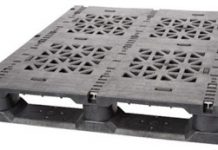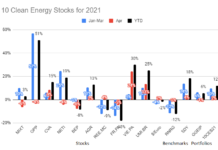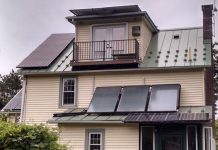Tom Konrad CFA
Geothermal Heat Pumps (GHP) are a niche market. They shouldn’t be.
Disclosure: Long WFIFF, short LXU puts (a net long position.)
A Better Mousetrap?
Ralph Waldo Emerson never said “Build a better mousetrap, and the world will beat a path to your door.” The mousetrap that likely inspired the misquote was invented seven years after his death. Unfortunately, many people take it literally. GHPs have all the hallmarks of a better mousetrap: They do the job of heating and cooling a building more efficiently than any other option. Despite the larger up-front cost, they are a mature technology and usually the most economic option for buildings that can accommodate them.
Not only can GHPs cut energy costs for heating and cooling by up to 80%, they can also provide other benefits such as essentially free hot water when in cooling mode, lower reliance on fossil fuels, and the elimination of above ground outdoor equipment. These advantages have earned GHPs a small but dedicated cult of true believers, but not broad market acceptance.
The world has not yet beaten a path to the GHP door. Instead, GHPs have a slim and only modestly growing market share. A study by Frost and Sullivan projects the market for GHPs in North American commercial buildings to grow at a 7.8% annual rate from 2012, 4.7% faster than the North American climate control market as a whole. An industry representative pointed me to a Navigant study which projects the world installed base to grow from 13.3 million tons to 36.2 million tons in 2020, see chart below.

Unfortunately, growth in installed base is not comparable to industry sales. For a young industry with a low installed base, sales are approximately the increase in the installed base. I eyeballed the chart to get annual estimates of world sales from the chart, and found that Navigant is projecting less than 5% sales growth in 2013 to 2015, followed by rapid growth (20-30%) in the 2016 to 2018 time frame. Navigant’s discussion makes clear that the later rapid growth rates require a revival of the economy and easier access to capital.
In the short term, Navigant’s study seems less optimistic than Frost & Sullivan’s, while it is more optimistic in the medium to long term. Using either projection, the near term less than 5% annual market share growth is clearly not the type of market transformation many would expect from a “better mousetrap.” Does the rapid market growth Navigant expects after 2015 have to depend so greatly on easy access to capital? Are other factors holding the GHP market back?
Siege Mentality
I struck a few raw nerves when I asked if air source heat pumps are a threat to geothermal heat pump suppliers last month, despite the fact that I answered my own question with a “No.”
Except in moderate climates, super-insulated homes, or situations where the installation of a geothermal heat pump (GHP) would be particularly difficult, GHPs have the better economics. This is despite recent advances in air source heat pump (ASHP) technology, which led me to ask the question in the first place. ASHPs don’t provide hot water, while many GHP systems can. Also, as the recent heavy snows in the Northeast demonstrated, there are some advantages to having a heat exchanger which is not exposed to the elements (see pic).
 One advantage of a geothermal heat pump’s ground loop compared to the air source heat exchangers shown is that you don’t have to dig them out after a snowstorm. This pic also shows an installation problem which is allowed under manufacturer specs, but may lead to less than optimal performance if both pumps are operating simultaneously: one heat exchanger blows air directly at the other. This problem is analogous to poor ground loop design for GHPs. |
Given all these advantages, why the raw nerves? I suspect it’s because geothermal heat pump sales continue to disappoint and proponents are looking for someone to blame.
ASHPs in Net-Zero Buildings
Another target of geothermal advocates’ ire is Marc Rosenbaum (who teaches the online Net Zero Energy Homes course in the Northeast Sustainable Energy Association’s Building Energy Masters Series.) He also raised hackles when he recommended minisplit air source heat pumps (ASHPs) for most single family net zero homes (I quoted Rosenbaum extensively in the previous article.)
He relates the story of the Putney School’s 16,000-square-foot Net-Zero Field House. The team designing this building modeled its heating costs using a GHP, and also using ASHPs with additional solar photovoltaics sufficient to provide the extra electricity needed to run the ASHPs. They found that it was cheaper to expand the solar system to power the ASHPs than it would have been to pay the extra installation costs of a GHP. Furthermore, the price of solar has fallen significantly since the Putney Field House was built; the price of the ground loop for a GHP has not.
Nevertheless, Rosenbaum’s preference for ASHPs in highly insulated buildings does nothing to explain GHPs’ low market share growth rate. Net Zero buildings are the exception, not the rule, and have a far lower market share than geothermal heat pumps. When the heating load is very low, the operating cost advantage from the greater efficiency of GHPs is not enough to repay the additional installation costs. That is not the case in 99.9% of new and existing buildings today.
GHPs Almost Everywhere Else
My own home, a farmhouse built in 1930, is much less efficient and requires a lot more heat than a Net Zero home, despite my own significant improvements. I don’t have enough suitable roof space for photovoltaics to make up for the extra energy ASHPs would require, even if that could be done economically. I opted for four ductless minisplit ASHPs rather than a GHP system, but it was because the minisplits allowed me to do the install without adding air ducts. Adding air ducts to my 85 year old home would have significantly increased the cost and disruption of installing a GHP system.
ClimateMaster, a division of LSB Industries (NYSE:LXU), makes a ductless split system called the Tranquility Console Series which probably would have been suitable for my needs, but I did not know about it until I received comments on an earlier version of this article telling me about it, nor did an
y of the geothermal installers I spoke to. Unfortunately, the efficiency ratings are low for GHPs with a COP of 3.3 in the ground loop configuration. This is not much better than the Mitsubishi air source units I had installed, which operate at a COP of around 2 from around -10° to 20°F outdoor temperatures, and exceed 3.3 COP when the ambient temperature is 35°F or more. The added efficiency at low temperatures would probably not have been sufficient to pay for the ground loop, but I would have been interested to get a quote. Waterfurnace Renewable Energy (TSX:WFI, OTC:WFIFF) offers the Envision Series Consoles with slightly higher heating efficiency (up to 3.5 COP) for certain models.

Barriers
Since GHPs are economic in most situations, other factors must be holding them back.
The relative complexity of a geothermal system is one likely suspect. As Rosenbaum says about ASHP minisplits,
“[O]ne thing I really like about the minisplits is how they are packaged systems from a single supplier, and are highly engineered as a system and therefore very reliable. GSHP systems are, at least where I have practiced, essentially custom engineered and installed, usually by several entities who have a shared responsibility to make sure the systems perform.”
Given the large up-front cost of a GHP system, the risk of a poor installation is likely to deter nonprofessionals from using GHPs even more than it deters experienced professionals like Rosenbaum.
The Curse of Complexity
The cure for installation risk would be a way to validate the performance of GHPs in the field, and track problems back to their source. When contractors lose the ability to blame others for their mistakes, they quickly stop making those mistakes or they go
out of business. Without such monitoring, it’s nearly impossible to track increased electricity use back to the source.
I recently spoke to Matt Davis, the co-founder of Ground Energy Support and a professor of hydrology at the University of New Hampshire. Ground Energy Support provides GHP monitoring to GHP owners and contractors, as well as data and analysis to support the development of the industry.
Ground Energy Support recently published a 14 page Homeowner Guide to Geothermal Heat Pump Systems. While I found the guide easy to understand, it makes clear that GHPs are not for everyone. The start of the guide directly helps homeowners decide if they and homes are suitable for a GHP, while its length indirectly makes the point that GHPs are not always “plug and play.” The six pages dedicated to finding and selecting a suitable GHP installer indirectly makes clear that the process is not for anyone with only casual interest in GHPs and their savings they bring.
If GHPs are to become commonplace, the process of financing and purchasing a reliable GHP system have to be simplified to the point where it becomes a matter of calling a name in the phone book. The success of SolarCity Corporation (NASD:SCTY) in providing solar to homeowners who are more interested in the green in their checking account than the green of their electricity shows the potential. That success is based on SolarCity’s ability to provide financing, installation, maintenance, and performance verification services internally. All the homeowner needs to do is pay the monthly bill for electricity production. The value proposition is simple: a hassle-free installation and savings from day one.
The SolarCity of Geothermal
Geothermal heat pumps also have the economic potential to deliver that same value proposition: hassle free installations, and reliable savings from day one. But if the industry is to achieve this potential, several things have to come together:
- A single company responsible for the entire installation, from engineering to installation to maintenance.
- Reliable monitoring of heat production from the ground loop.
- A financing tied to the geothermal installation itself, to allow a lease-like structure which allows homeowners to see the benefits from day one.
We already have the corporate and financial structures to bring the solar lease model to GHPs. In fact, it takes little stretch of the imagination to see a solar lease company acquiring or partnering with GHP installers and offering a geothermal lease along with the solar lease to its customers. In cold climates not known for their sunny winters such as the Northeast US, the underlying economics of GHPs are far superior to those of solar photovoltaics. These economics should enable very attractive GHP leases, as soon as the other pieces are in place.
First, the homeowner and the geothermal lease company would have to have a reliable, objective way to monitor the performance of the GHP system.
Geothermal Monitoring
Ground Energy Support is tackling this problem with its GXTracker, which monitors the heat output of the ground loop and monitors or models the electricity consumption of the pump itself. Heat production monitoring lets everyone know if a system is operating as designed, and helps diagnose the problem when it is not.
Of the 30 GHP systems Ground Energy Support has been monitoring for the last two and a half years, 60% have had some operational, maintenance or mechanical issue. Most of these were minor maintenance issues or improper settings which caused only minor drops in performance, but which would have gotten worse if undetected. But 17% of the systems had significant design or installation problems. A third of these were oversized systems which can lead to higher energy costs but were likely the result of homeowner preferences. Another third were easily fixable and not the fault of the installer: a failed heat pump (covered under warranty), and an air duct which was left open to an unfinished garage. The rest (high pumping penalty caused by too large a pump or too small pipes, and an undersized ground loop) could have been avoided if the homeowner had been able to vet the installers’ track records – another potential benefit of ubiquitous monitoring.
One other way proper monitoring of GHPs might help the industry is enabling the implementation of incentives for renewable heat production from geothermal ground loops, analogous to the incentives for photovoltaics. The Massachusetts legislature currently working on a bill to allow heating and cooling with renewable fuels to benefit from the same incentives the state give to renewable electricity. The bill states that the heat must be “verified through an on-site utility grade meter” or similar means.
Conclusion
Advocates of geothermal heat pumps should spend less time discussing the well established attractive economics of GHPs in theory, and more time delivering those economics. The key to this is making the buying process simple for the customer while providing verification and taking responsibility if those economics fail the be acheived . While GHPs are not the best fit for every home, in many climates the majority of such homes will benefit more from a GHP system than a new conventional heating and cooling system.
The solar lease is an excellent model for taking a renewable energy system and making it attractive to the general public. The GHP industry can follow down this path, but first it has to adopt reliable monitoring as a standard feature. This will hold installers to account for their design and implementation, while giving customers confidence that they will get what they pay for.
Adopting monitoring could start with customers wanting to know that their systems are operating as designed. It could also begin with states like Massachusetts giving incentives for verifiable renewable heat production, or an installer deciding to break open the market by offering a geothermal lease. UPDATE: It looks like at least one installer, Orca Energy, is alreadyoffering a geothermal lease to developers of new homes in a partnership with GHP manufacturer Bosch Thermotechnology. New homes are a natural starting point for residential geothermal leases because of the lower installation costs and greater ease of design.
It seems to me that the group that has both the most to gain and the most power to affect change is GHP manufacturers. If they were to include monitoring as a standard feature, they might be able to catalyze this market themselves.
To Davis’ knowledge, only Waterfurnace Renewable Energy (TSX:WFI, OTC:WFIFF. Disclosure: I own this stock.) and Modine Manufacturing Company (NYSE:MOD) currently offer any sort of energy monitoring. Modine’s is part of their optional Orb controller. Waterfurnace seems farthest along in this regard. Sensors are standard on Waterfurnace’s most advanced (and efficient) models, the 7 Series. According to the company, the thermostat retains 13 months of energy usage data. I’m inquiring to determine if that includes heat production.
I suspect the extra costs of making such monitoring standard would be more than compensated by greater customer satisfaction and increasing sales.
Is this the start of a move by manufacturers towards better monitoring, or will change come from the bottom up? If geothermal heat pump sales are going to soar, change will have to come from somewhere.
This article was first published on the author’s Forbes.com blog, Green Stocks on February 28th.
DISCLAIMER: Past performance is not a guarantee or a reliable indicator of future results. This article contains the current opinions of the author and such opinions are subject to change without notice. This article has been distributed for informational purposes only. Forecasts, estimates, and certain information contained herein should not be considered as investment advice or a recommendation of any particular security, strategy or investment product. Information contained herein has been obtained from sources believed to be reliable, but not guaranteed.









Have you compared GHP/ASHP to evacuated tubes and adsorption chillers…?
http://en.wikipedia.org/wiki/Evacuated_tube_collector#Evacuated_tube_collectors
http://www.aaamachine.com/exhibition/20130128/
http://www.mpi.co.jp/english/news/201203140474.html
http://www.sortech.de/en/
Might be viable in a cooling climate, but solar thermal heating has trouble in the heating climates I was talking about given the short winter day.
Along with the environment benefits, I see renewable energy as being a income opportunity and continue to put money into speeding up its progress. I really believe that by helping to power up more of the planet by using renewable energy, we’re making a significantly better future for everybody.